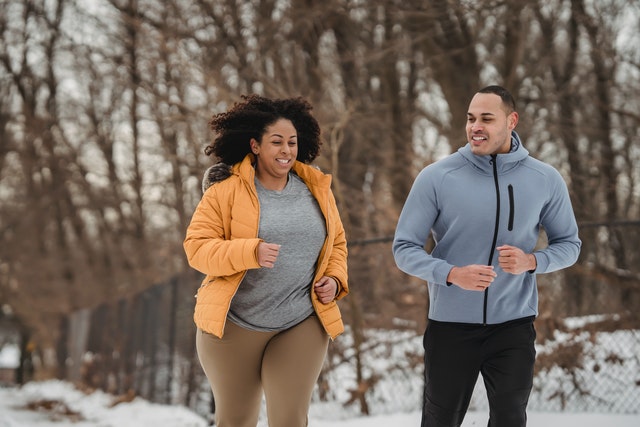Many athletes want to train outside in the winter too. You can also train in snow and cold and even benefit from it if you observe some tips!
7 Tips For Training In Winter: Many free athletes train outside, even in winter. At least to complete the running sessions, the dining room is not the right place. In general, you can exercise while it rains or snows. Changes in temperature and air quality strengthen the immune system, so you can even take advantage of bad weather! In addition, the body counteracts the cold with a higher heart rate (thermoregulation), which greatly increases energy consumption, and makes training more efficient. However, it is important that you follow a few rules in winter because the cold can be dangerous. As a basic principle, we all have an individual temperature sensitivity, which must always be considered. To measure it, it is not enough to obey the thermometer as the only indicator.
Spend More Time Warming Up:
The body has a harder time warming up in winter, like cars. If you start cold, you can injure yourself since training without having properly warmed up can cause damage to muscles, tendons, ligaments, and joints. That’s why you should give much importance to your warm-up!
Read More: 6 factors that do not let you achieve your goals in the gym
Keep moving:
The way you complete the training is as important as the correct preparation. Once you’ve finished a run, cool down for a few minutes before getting into a warm place to stretch so your muscles don’t seize up. In winter, the muscles cool down very quickly, so all the waste from the contraction cannot be removed from the bloodstream in time. Consequently, muscle spasms and even injuries occur if they have been “broken” later. If you push yourself at the end of the training session, make sure you don’t sit or lie down after you’re exhausted; if you do, the circulation slows down very quickly, and the muscles tense.
Put On Warm Clothes:
The fact that to train in winter you need to wear warm clothes is obvious. However, it’s easy to underestimate temperatures, especially when you’ve spent the day indoors before training or the wind picks up just as you’re outside. Dressing in cold weather is best done with the so-called “onion principle,” which suggests dressing in easy-to-remove layers that allow for changes in body temperature. Make sure you wear enough layers and cover the extremities, as they radiate much heat. You can find more tips on what to wear to train in winter in our blog.
Watch Your Breath!:
The colder the air, the greater the stimulation to the bronchi, lungs, and mucous membranes. On the one hand, the cold causes the bronchial tubes to constrict while at the same time reducing the ability of the mucous membranes to stay moist. The typical burning or sore throat occurs when you inhale a lot of cold air, which causes a slight swelling, and is a clear sign that it is too cold to exercise outside. Please pay attention to it and try to inhale as much as possible through your nose and exhale through your mouth. If you breathe like this, the air makes a long journey towards the lungs and thus, has more time to moisten and warm up through the nasal mucosa and the mouth. The air passing through the mouth is moistened and heated during exhalation and allows efficient breathing through this channel when necessary. It may also be helpful to wear a breathing mask or a scarf over your nose and mouth, to further warm and humidify the cold air during inspiration. You should not exercise outside in temperatures below -15°C as much as possible.
At this temperature, the body cannot heat the air sufficiently before reaching the lungs. Illnesses that can arise from cold breathing range from severe cold to pneumonia. Asthmatics have to follow some special rules, whatever the temperature, so consult your doctor first. It may also be helpful to wear a breathing mask or a scarf over your nose and mouth, to further warm and humidify the cold air during inspiration. You should not exercise outside in temperatures below -15°C as much as possible. At this temperature, the body cannot heat the air sufficiently before reaching the lungs. Illnesses that can arise from cold breathing range from severe cold to pneumonia. Asthmatics have to follow some special rules, whatever the temperature, so consult your doctor first. It may also be helpful to wear a breathing mask or a scarf over your nose and mouth, to further warm and humidify the cold air during inspiration. You should not exercise outside in temperatures below -15°C as much as possible. At this temperature, the body cannot heat the air sufficiently before reaching the lungs. Illnesses that can arise from cold breathing range from severe cold to pneumonia. Asthmatics have to follow some special rules, whatever the temperature, so consult your doctor first. At this temperature, the body cannot heat the air sufficiently before reaching the lungs. Illnesses that can arise from cold breathing range from severe cold to pneumonia. Asthmatics have to follow some special rules, whatever the temperature, so consult your doctor first. At this temperature, the body cannot heat the air sufficiently before reaching the lungs. Illnesses that can arise from cold breathing range from severe cold to pneumonia. Asthmatics have to follow some special rules, whatever the temperature, so consult your doctor first.
Contant Credit: https://www.google.com/
Don’t Stay Out Too Long.
After training, get into a warm place as quickly as possible and remove all wet or sweaty clothes because right after exposure, the immune system is especially weak and vulnerable. This immune hole is very dangerous. It is called an “open window” present in the first half-hour after training. In this time, the body is especially susceptible to colds and infections.
Train For The Day
Whenever possible, choose the morning or midday to plan the training. It is the hottest time of the day, and when the sun is in the best position to stimulate the production of vitamin D. In winter, many suffer from vitamin D deficiency, which is very important for bones and joints and lifts their spirits. Free athletes are not in a bad mood even in winter!
Eat lots of fruits and vegetables.
Also, make sure to support your immune system with a balanced diet rich in vitamins and minerals. Fruits and vegetables should be the basis of that diet. Any tuber, all types of cabbage, and winter salads such as lettuce, endive, or red radicchio should be present in your dishes. Winter fruits like tangerines, pomegranates, and all year-grown varieties like pears and apples provide an extra dose of vitamins to make you cold hardy.








